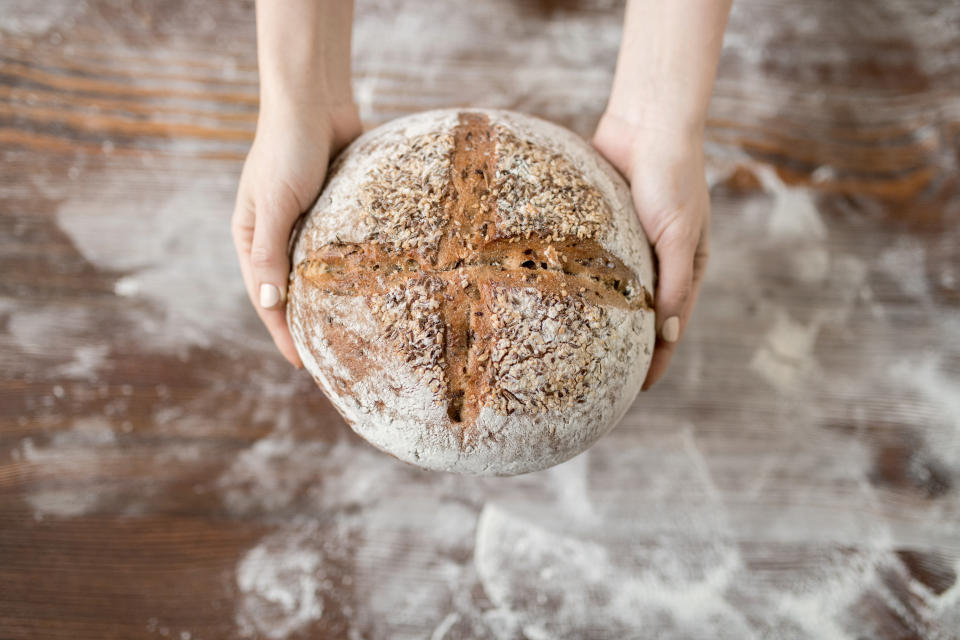We independently evaluate the products we review. When you buy via links on our site, we may receive compensation. Read more about how we vet products and deals.
Everyone's baking bread, but there's no 'regular' flour left—here's a solution
Yahoo Lifestyle is committed to finding you the best products at the best prices. We may receive a share from purchases made via links on this page. Pricing and availability are subject to change.

Instagram is filled with photos of people showing off their homemade bread—but not for long. Like toilet paper and paper towels, it’s now next-to-impossible to find all-purpose flour and bread flour in stores. Looking online? Good luck with that.
People are buying yeast and flour in droves, making it incredibly difficult to find the stuff. Yeast, which helps bread and other baked goods rise, saw a 647% growth in sales the week of March 15 compared to the previous year, according to Nielsen data.
Robb MacKie, president and CEO of the American Bakers Association, told Business Insider that demand for baking goods like yeast and flour exploded virtually overnight. "An extended spike of demand hit the system hard and unexpectedly," he said. "We could have handled twice the normal demand. But five times the normal [demand] almost overnight—no one can prepare for that."
This flour (and yeast) shortage shouldn’t last forever: MacKie said companies are working hard to restock supplies. "The industry is cranking product like you wouldn't believe all up and down the supply chain," he said.
That doesn’t mean you can’t bake in the meantime. There are other types of flour out there—just not the standard kind most have been used to baking with. Luckily, you can still make plenty of good stuff with alternative flours. Here’s what you can do with each, according to nutritionists.
Gluten-free flour
This is the next closest thing to all-purpose flour, but “it’s more difficult to work with,” Gina Keatley, a CDN practicing in New York City, tells Yahoo Lifestyle.
Gluten is a protein that gives structure to baked goods. “It’s that spongy, airy texture that we think of with some baked goods,” Keatley explains. If you simply swap in gluten-free flour for regular flour, it can create baked goods that are crumbly, she says. “But some companies have already added gluten replacements to their flour, so check the label,” Keatley says.
Additions like xanthan gum and guar gum can make a gluten-free flour act more like all-purpose flour, Keri Gans, RD, author of The Small Change Diet, tells Yahoo Lifestyle. However, you can also buy those ingredients separately and add them to gluten-free flour for a similar effect.
Almond flour
Almond flour—which is made from finely ground almonds—has been having a moment for a while now, and regularly shows up in recipes for muffins and other baked goods. It can even be used to bake bread, Gans says. “Since it is a little heavier in weight than regular flour, you will need to slightly increasing the amount of rising agent you use, i.e. baking powder or soda,” she says.
You can also use almond flour instead of breadcrumbs for chicken cutlets, fish filets, or in meat loaf or a meat ball recipe that calls for bread. “It’s also good for pancakes and waffles,” Gans says.
Keep in mind that you’ll need to experiment a little if you’re planning to swap almond flour into recipes you love. “The batter is going to look thicker, you're going to have to adjust the fat/oils added since nuts have more fat, and you may need to increase your leavening agent since it is going to be harder to get the same consistency,” Keatley says.
Tapioca flour
Tapioca flour, aka cassava flour, is made from the starch of the cassava root and is finely ground. It can help add texture to gluten-free baked goods, but can also replace cornstarch in recipes, Gans says. It can even be used as a thickening agent for pies and sauces, she says.
Coconut flour
Coconut flour is loaded with saturated fat and is “crazy absorbent,” so it’s not a great substitute for all-purpose flour in recipes, Keatley says. Because coconut flour is so absorbent, “you need to add more liquid, such as eggs,” Gans says. Coconut flour is better for making things like brownies, cakes, and cookies, as well as adding a crust to meats.
Quinoa flour
Quinoa flour is is made by grinding quinoa grains into fine particles to get flour. It can work in baked goods, as well as pancakes and waffles, Gans says. It’s similar to almond flour, she says, and can be used in lieu of breadcrumbs when you want something a little different.
Shop it: Vitacost Certified Organic Quinoa Flour, $6.50, vitacost.com
Read More from Yahoo Lifestyle:
NASA says these 8 plants are the best at purifying the air in your home
Where to buy household essentials: Hand sanitizer, toilet paper, disinfectant wipes, and more
I tried the Bear mattress to help with my stiff, achy joints and here's what happened
Follow us on Instagram, Facebook, Twitter, and Pinterest for nonstop inspiration delivered fresh to your feed, every day.
Want daily pop culture news delivered to your inbox? Sign up here for Yahoo’s newsletter.






